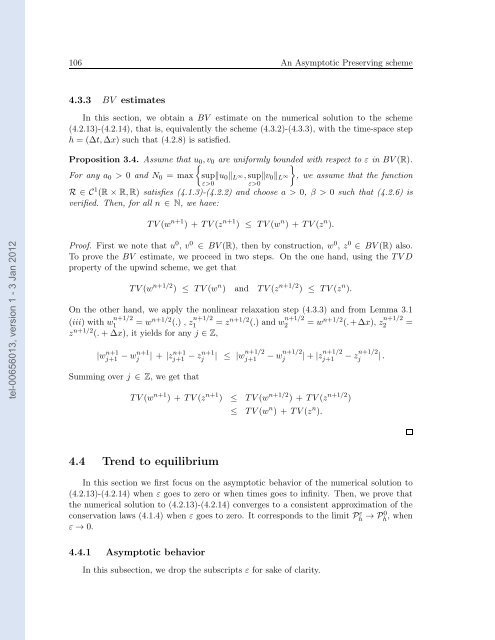Modélisation, analyse mathématique et simulations numériques de ...
Modélisation, analyse mathématique et simulations numériques de ...
Modélisation, analyse mathématique et simulations numériques de ...
You also want an ePaper? Increase the reach of your titles
YUMPU automatically turns print PDFs into web optimized ePapers that Google loves.
tel-00656013, version 1 - 3 Jan 2012<br />
106 An Asymptotic Preserving scheme<br />
4.3.3 BV estimates<br />
In this section, we obtain a BV estimate on the numerical solution to the scheme<br />
(4.2.13)-(4.2.14), that is, equivalently the scheme (4.3.2)-(4.3.3), with the time-space step<br />
h = (∆t,∆x) such that (4.2.8) is satisfied.<br />
Proposition 3.4. Assume that u0,v0 are uniformly boun<strong>de</strong>d with respect to ε in BV(R).<br />
For any a0 > 0 and N0 = max supu0L<br />
ε>0<br />
∞,supv0L<br />
ε>0<br />
∞<br />
<br />
, we assume that the function<br />
R ∈ C1 (R × R,R) satisfies (4.1.3)-(4.2.2) and choose a > 0, β > 0 such that (4.2.6) is<br />
verified. Then, for all n ∈ N, we have:<br />
TV(w n+1 ) + TV(z n+1 ) ≤ TV(w n ) + TV(z n ).<br />
Proof. First we note that u 0 , v 0 ∈ BV(R), then by construction, w 0 , z 0 ∈ BV(R) also.<br />
To prove the BV estimate, we proceed in two steps. On the one hand, using the TVD<br />
property of the upwind scheme, we g<strong>et</strong> that<br />
TV(w n+1/2 ) ≤ TV(w n ) and TV(z n+1/2 ) ≤ TV(z n ).<br />
On the other hand, we apply the nonlinear relaxation step (4.3.3) and from Lemma 3.1<br />
(iii) with w n+1/2<br />
1 = wn+1/2 (.) , z n+1/2<br />
1 = zn+1/2 (.) and w n+1/2<br />
2 = wn+1/2 (.+∆x), z n+1/2<br />
2 =<br />
zn+1/2 (.+∆x), it yields for any j ∈ Z,<br />
|w n+1<br />
j+1 −wn+1<br />
j | + |z n+1<br />
j+1 −zn+1<br />
j | ≤ |w n+1/2<br />
j+1 −wn+1/2<br />
j |+|z n+1/2<br />
j+1 −zn+1/2<br />
j |.<br />
Summing over j ∈ Z, we g<strong>et</strong> that<br />
TV(w n+1 ) + TV(z n+1 ) ≤ TV(w n+1/2 ) + TV(z n+1/2 )<br />
4.4 Trend to equilibrium<br />
≤ TV(w n ) + TV(z n ).<br />
In this section we first focus on the asymptotic behavior of the numerical solution to<br />
(4.2.13)-(4.2.14) when ε goes to zero or when times goes to infinity. Then, we prove that<br />
the numerical solution to (4.2.13)-(4.2.14) converges to a consistent approximation of the<br />
conservation laws (4.1.4) when ε goes to zero. It corresponds to the limit Pε h → P0 h , when<br />
ε → 0.<br />
4.4.1 Asymptotic behavior<br />
In this subsection, we drop the subscripts ε for sake of clarity.

















